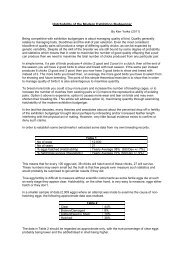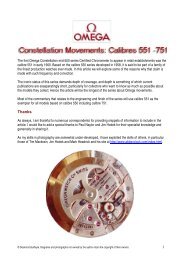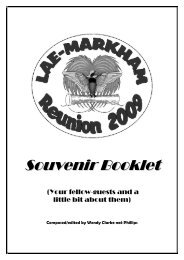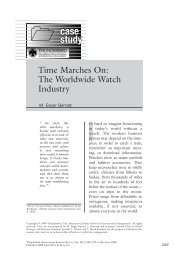A Case Study
A Case Study
A Case Study
Create successful ePaper yourself
Turn your PDF publications into a flip-book with our unique Google optimized e-Paper software.
So, if you discovered a calibre 751 movement sitting in a case<br />
168.004 instead of case 168.016 as in the example overleaf,<br />
you would be alerted immediately to the work of a rather<br />
perverted Doctor Frankenwatch!<br />
Crowns<br />
The most famous of the Constellation crowns were the ‘tensiders’<br />
used in the 1950s and earlier 60s models. BF 1080<br />
(2.00mm tube diameter) has now been discontinued while BF<br />
1060 (2.5mm tube diameter) is still available as at 2007.<br />
The standard for all Constellation watches until ref. 168.004 and<br />
the C-Shaped cases is the ten-sided crown with the reference<br />
numbers mentioned above. Omega has since substituted a<br />
round crown for the discontinued ten-sider, however, to repeat,<br />
all case numbers to 168.004 originally featured a ten-sided<br />
crown.<br />
Correct crowns are determined by case back numbers. One<br />
way in which to establish if the crown on your Constellation<br />
meets specifications is to access the web pages of jewellery<br />
supplier Otto Frei: http://www.ofrei.com/page_147.html<br />
While, from some accounts, the people at the Otto Frei<br />
establishment are not the most pleasant of people to deal with,<br />
the web site is a mine of information. Use the search function<br />
(enter, for example, “2943 crown”) and you will be directed<br />
quickly to the part number that matches the case back number.<br />
In many instances there are photographs of the crown, which<br />
enable you to ascertain visually if a crown is correct.<br />
<strong>Case</strong> Condition<br />
The best measure of case condition is sharpness of lines. As<br />
mentioned later, the pre dogs-leg cases made quite an<br />
aggressive design statement with strong definition and distinct<br />
lines. This statement is forever compromised when zealous or<br />
dim-witted restorers decide to give the case a “bit of a polish”<br />
and don’t know when to stop.<br />
Example of overzealous polishing that removes the original<br />
case finish. In this case, the vendor effectively sliced US200.00<br />
off the value of the watch<br />
<strong>Case</strong> 2853 solid gold case Calibre 501: Note wear around bezel<br />
and lugs caused by over-polishing.<br />
Earlier Constellations were highly polished. Any polishing out of marks and dings should maintain strictly the<br />
distinct symmetry of the case. Many dealers and watchmakers make the mistake of polishing the life out of<br />
cases, leaving them bereft of their original character. Later Constellations often featured satin or brushed<br />
finishes, and, once again, zealous polishers often eliminate the original finish in an attempt to remove signs of<br />
wear and tear, as per the example above top.<br />
From a collecting point of view, a sharp case with a few surface scratches and minor dings is preferable to an<br />
overly polished one that has been transformed into a soulless shell devoid of its original charm. When<br />
examining a case with a view to purchase, either avoid cases that have lost their definition through wear or<br />
over-polishing or discount the price accordingly.<br />
3
















